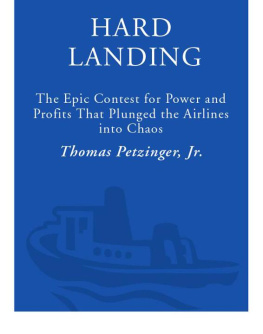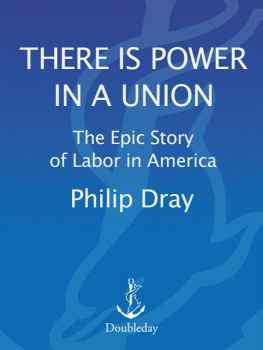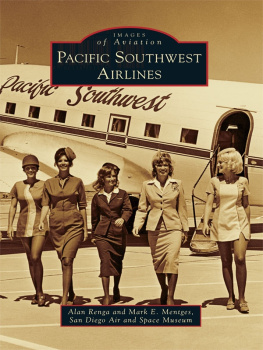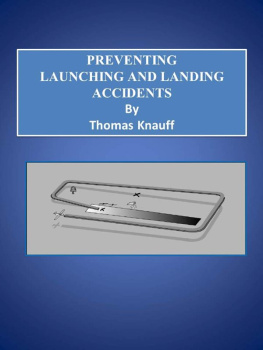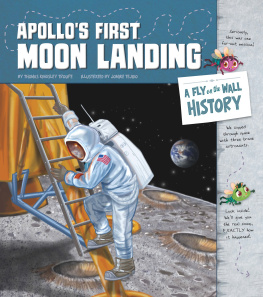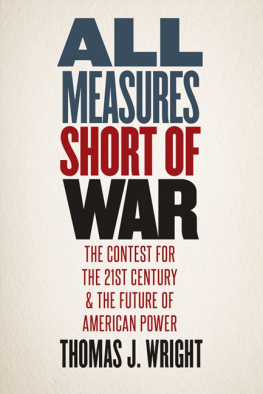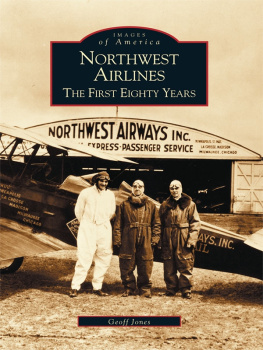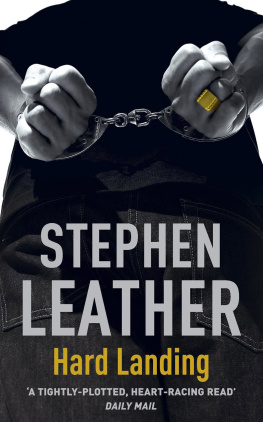ACKNOWLEDGMENTS
I grew up around the airlines. As a teenager I handled baggage and freight for United Airlines. My late grandmother, Beatrice V. March, founded a travel agency in Ohio 40 years ago. My father, Thomas V. Petzinger, Sr., built it into a business well known for integrity and innovation. My brother, Charles C. Petzinger, is now building the business into a world-class operation. Over the years my mother, Jean March Petzinger, and my sister, Elizabeth Ann Holter, involved themselves in the agency whenever it required class.
My first thanks thus go to my relatives for exposing me to the delights of the travel profession. Only now, after researching this book, do I appreciate how hard they have had to work to extract a living from it.
I owe a tremendous debt to my sources, who are listed elsewhere. In addition to thanking them for their time, trust, and candor, I wish to extend my regrets to each and every one of them that this is not precisely the book any of them might have wished me to write.
At The Wall Street Journal, I thank Paul Steiger, the managing editor, who kept a job open for me while I disappeared to work on this project. News editor Cynthia Crossen helped assure a soft landing on my return. For their encouragement, moral support, and reporting assistance along the way, I thank my Journal colleagues Jill Abramson, Laurie Cohen, Brian Coleman, Al Hunt, Bruce Ingersoll, Hal Lancaster, Laurie McGinley, Walt Mossberg, Alan Murray, Asra Nomani, Rick Wartzman, and David Wessel, as well as my former colleagues Eugene Carlson, Jim Stewart, and Peter Truell. I especially wish to thank the Journals Bridget OBrian, who not only shared her insights but provided years of outstanding coverage on which this manuscript heavily relies.
Apropos of that, I am grateful to many other current and former Journal reporters whose trailblazing reporting precedes my efforts here. They include Teri Agins, Jeff Bailey, Buck Brown, Bryan Burrough, Harlan Byrne, Susan Carey, Gary Cohn, John Curley, Jon Dahl, Bob Davis, Steve Frazier, George Getschow, Dick Gibson, Roy Harris, Jim Hirsch, Al Karr, Scott Kilman, John Koten, Joann Lublin, Mike McCarthy, Priscilla Meyer, Daniel Pearl, Brett Pulley, Carl Quintanilla, Bob Rose, Dean Rotbart, Brent Schlender, Ron Shafer, Randy Smith, Roger Thurow, and Judy Valente. I would like to single out the Journals Bill Carley, who covered more big stories than anyone else during much of the period encompassed by this book.
There is a regrettable trend in business journalism to resist acknowledging the work of people at other publications. I am proud to cite the work of outstanding journalists from elsewhere, including, at Fortune, Kenneth Labich, Rush Loving, Jr., Louis Kraar, and Peter Nulty; at Business Week, Aaron Bernstein; John Byrne, Reggi Ann Dubin, James Ellis, Pete Engardio, Chuck Hawkins, and Jim Norman; at Aviation Week, James T. McKenna, James Ott, and Carole A. Shifrin; at Crains Chicago Business, Mark Hornung; at the Chicago Tribune, Carol Jouzaitis and Jim Warren; at The New York Times, Adam Bryant and Agis Salpukis; at Air Transport World, Joan Feldman; at The Washington Post, Richard Weintraub; and writing in Texas Monthly, William P. Barrett, James Fallows, and Jan Jarobe.
Anyone who writes a book about commercial aviation owes an incalculable debt to Robert Daley, R.E.G. Davies, Robert Serling, and Carl Solberg, who have written outstanding histories. Two other authorsDan Reed, who has written a biography of Robert Crandall, and Capt. John J. Nance, who wrote an account of Braniffs failuregenerously shared insights with me.
I cannot mention everyone in the airline industry who provided help, but I would like to single out a few: at American Airlines, Al Becker, Iain Burns, Lizanne Peppard, and the infinitely patient and helpful John Hotard; at British Airways, Sandy Gardner, Peter Jones, John Lampi, Derek Ross, and David Snelling; at Southwest Airlines, Helen Bordelon, Ginger Hardage, Kristie Kerr, and Ed Stewart; at the Air Line Pilots Association, John Mazor and Kathy White; at United Airlines, Millie Borkowski and Jan Johnson. Thanks also to one of the greatest knowledge resources in the airline industry, Marion Mistrik, chief librarian at the Air Transport Association in Washington, D.C.
A number of my friends and associates read all or part of the manuscript and provided valuable comments; my thanks to Bob Cross, Katherine Field, Stephen Holter, Joe Meier, Bridget OBrian, Carolyn Phillips, and Babak Varzandeh. Dick Tofel found bloopers that no one else would have caught. The toughest copy editor I knowmy mother, Jean Petzingerread every word a couple of times and improved more of them than I can count.
I have been blessed with intelligent and dedicated researchers. Cortney Murdoch rounded up records across the country. Babak Varzandeh endured the frustrations of the SEC. John Whittier joined me for countless hours over photocopiers. Jennifer Reingold, Colin Cowles, and Cass DuRant helped me accumulate a massive library of clippings.
Friends, family, and associates provided assistance in many other ways. Ed Upton, a model of virtue, helped me understand how the airline industry works and how an airplane flies. Lisa Petzinger helped me understand how reservation networks operate. I received valuable insights and information from Steve Frazier, Harry Litwin, Dina Long, and Bob Schettino; introductions from Karen Ceremsak, Henry Griggs, and Joe Jamail; and vital favors from Patrick Forte, Al Gibson, Chris Long, Robert Meeks, Jan Norris, Susan Purseley, Beth Shannon, Dominic Suprenant, Shelly Winebold, and the crew at Pan Atlas Travel Service.
At Random House and Times Books, Peter Osnos was a true believer in this book and never seemed to doubt the outcome, even when he probably should have. Miranda Brooks, Henry Ferris, Carie Freimuth, Diane Henry, Lesley Oelsner, Beth Pearson, Mary Beth Roche, and Laura Taylor also were great allies. Copy editor Peg Haller made more spectacular catches than I wish to admit. But my deepest thanks go to Steve Wasserman, the editorial director of Times Books, who took on this project midway through the process and gave it the attention an adopted child requires. It will horrify the reader to know that at one point the manuscript of this book was nearly double its present length; the guidance, spirit, and talent of Steve Wasserman helped turn it into a real book.
I wish also to acknowledge my literary agent, Alice Fried Martell, the epitome of integrity and good humor, and a wonderful friend.
For their toleration and inspiration I thank my children, Beatrice, Eva, and Janis. And mostly I thank my wife, Paulette Thomas, who covered the story, nurtured the manuscript, defended my sanity, and kept our family whole. Though I deserved less, she never for a minute let me down.
A LSO BY T HOMAS P ETZINGER , J R .
Oil and Honor: The Texaco-Pennzoil Wars
ABOUT THE AUTHOR
T HOMAS P ETZINGER , J R ., grew up in Youngstown, Ohio, and received his journalism degree from Northwestern University. For the last seventeen years he has been a reporter and editor for The Wall Street Journal. His wife, Paulette Thomas, is also a Journal reporter. They have three children.
BIBLIOGRAPHY
Books
Allen, Oliver E. The Airline Builders. Alexandria, Va.: Time-Life Books, 1981.
Bashe, Charles J., Lyle R. Johnson, John H. Palmer, and Emerson W. Pugh. IBMs Early Computers. Cambridge, Mass.: MIT Press, 1986.
Banks, Howard. The Rise and Fall of Freddie Laker. London: Faber and Faber, 1982.
Bender, Marilyn. At the Top. Garden City, N.Y.: Doubleday, 1975.

